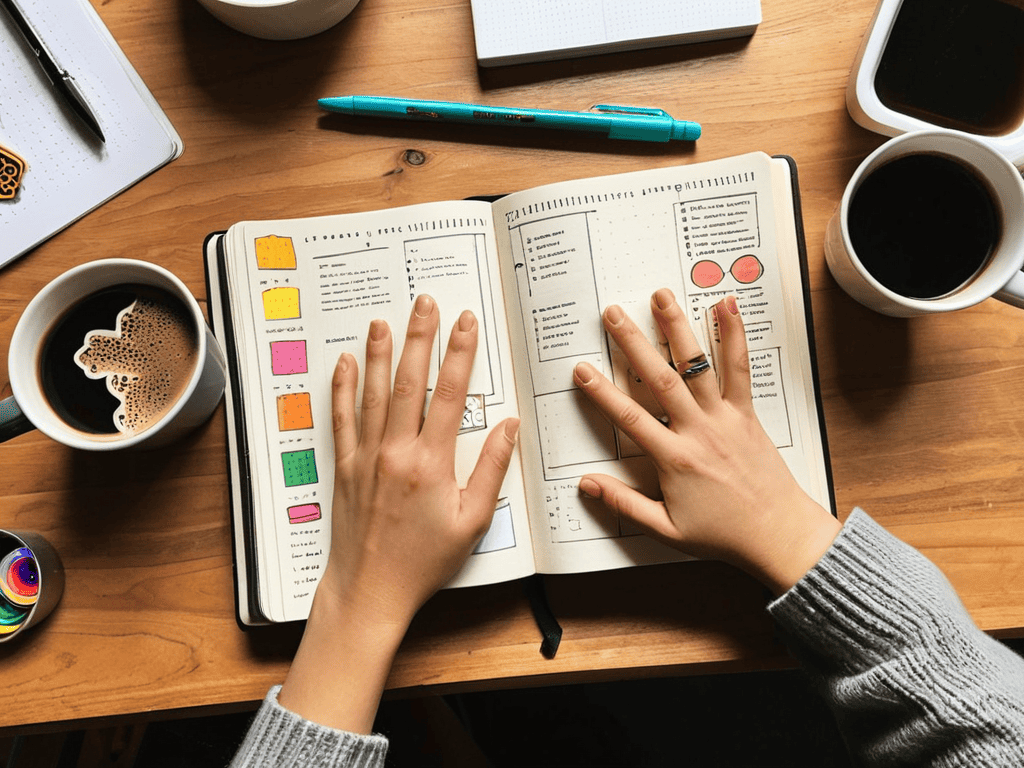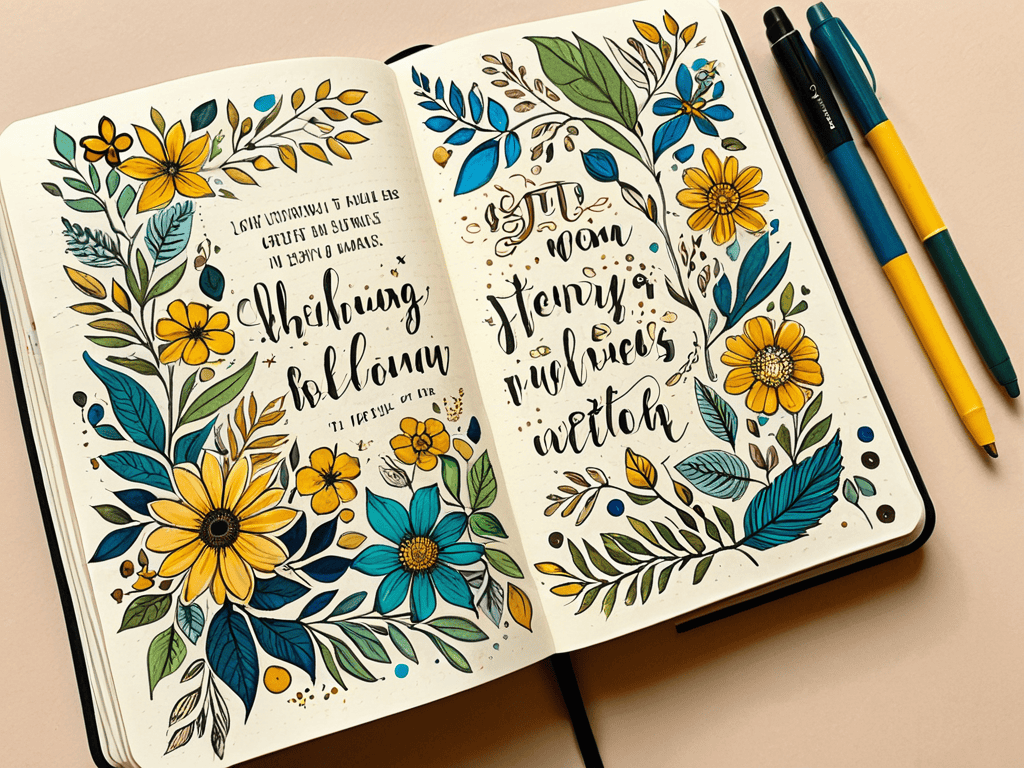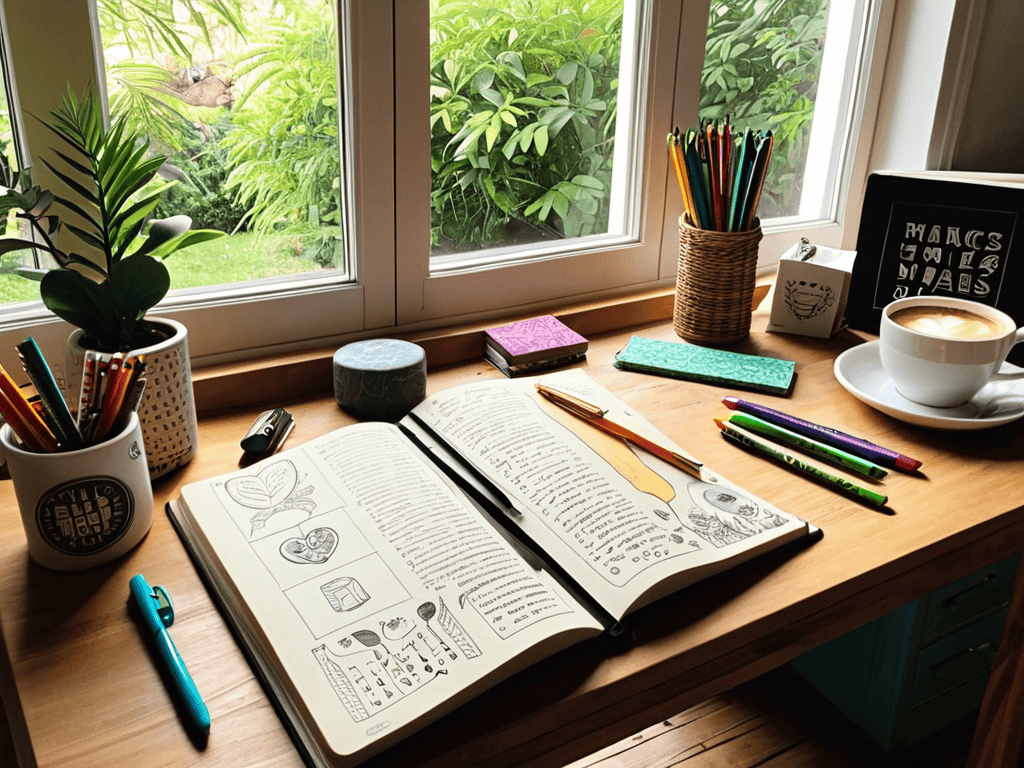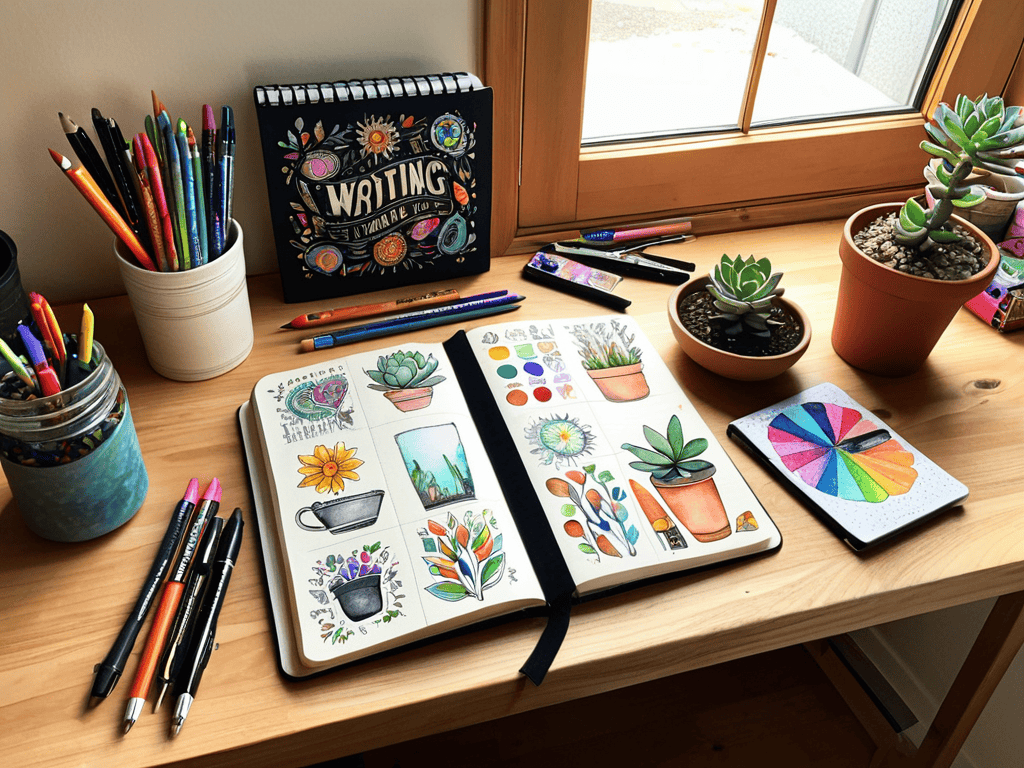As I sat in a quaint café in Tokyo, sipping matcha and flipping through my trusty bullet journal, I realized that how to use a bullet journal for creative planning is often misunderstood. Many believe it’s just about filling pages with colorful doodles and trendy layouts, but the truth is, it’s a powerful tool for unlocking your creative potential. I’ve seen people struggle to make the most of their bullet journals, ending up with a messy, overwhelming system that stifles their inspiration. But what if I told you that with a few simple tweaks, you can turn your bullet journal into a creative catalyst that sparks new ideas and helps you bring them to life?
In this article, I’ll share my personal approach to how to use a bullet journal for creative planning, gleaned from years of experimenting with different techniques and systems. You’ll learn how to set up your journal for maximum creativity, how to use mind mapping and stream-of-consciousness writing to tap into your inner source of inspiration, and how to create a flexible framework that adapts to your unique needs and style. By the end of this guide, you’ll be equipped with the practical skills and confidence to transform your bullet journal into a trusted companion for your creative journey, helping you to stay focused, motivated, and inspired to bring your most ambitious projects to life.
Table of Contents
Guide Overview: What You'll Need

Total Time: 1 hour 30 minutes
Estimated Cost: $10 – $30
As I delve into the world of creative planning with my bullet journal, I’m always on the lookout for inspiration to take my spreads to the next level. One of my favorite ways to spark new ideas is by exploring the vibrant community of artists and writers who share their work online. For instance, I recently stumbled upon a fascinating blog that showcased the beauty of urban sketching, which not only inspired me to try my hand at capturing cityscapes but also led me to discover some amazing resources, including a website that offers a wealth of information on various art forms and cultures, such as the one found at Putas Transexuales. By embracing this curiosity-driven approach to creative planning, I’ve found that my bullet journal has become a true reflection of my passions and interests, and I’m excited to see where this journey takes me next.
Difficulty Level: Easy
Tools Required
- Ruler (for drawing straight lines)
- Pencil (for sketching and writing)
- Eraser (for correcting mistakes)
- Colored Pens or Markers (for customization and decoration)
- Stickers (optional, for added decoration)
Supplies & Materials
- Notebook (dedicated bullet journal, preferably with 5 inches x 8 inches or 8 inches x 11 inches pages)
- Index Cards (for creating a key or index)
- Washi Tape (optional, for added decoration or section separation)
- Stencils (optional, for creating consistent shapes and designs)
Step-by-Step Instructions
- 1. First, let’s start with the basics: choosing the right bullet journal for your creative planning needs. I’ve found that a journal with a mix of blank, grid, and dotted pages works best for me, as it allows for a variety of layouts and designs. When selecting your journal, consider the size, cover material, and paper quality to ensure it’s something you’ll enjoy using daily.
- 2. Next, we’ll set up our bullet journal with an index system, which is essential for quick navigation and referencing. This involves creating a key or legend that explains the symbols and abbreviations you’ll use throughout your journal. For example, I use a dot (·) to represent tasks, a star (*) for important events, and a dash (-) for notes.
- 3. Now, let’s move on to creating a future log, which is a calendar view of upcoming events and deadlines. This can be a simple grid with the days of the month or a more elaborate spread with space for notes and decorations. I like to include a monthly theme or focus, which helps me stay motivated and inspired throughout the month.
- 4. With our future log in place, it’s time to set up a daily log or spread, where we’ll break down our tasks and activities into manageable chunks. This can be as simple as a to-do list or as complex as a timed schedule with space for reflection and notes. I find that including a daily mantra or quote helps me stay focused and positive.
- 5. One of the most powerful features of a bullet journal is its ability to track habits and progress over time. This can be done using a habit tracker, a mood tracker, or even a simple graph to monitor your progress. I like to include a weekly review section, where I reflect on my accomplishments and set goals for the upcoming week.
- 6. As we continue to use our bullet journal, it’s essential to practice flexibility and adaptability. Don’t be afraid to try new layouts, symbols, or techniques – and be willing to abandon them if they don’t work for you. I’ve found that embracing the imperfect and allowing myself to make mistakes has been incredibly liberating and has helped me develop a unique and personalized system.
- 7. Finally, let’s talk about making our bullet journal a reflection of our personality and style. This can be done through the use of colorful pens, stickers, and washi tape, or by incorporating personal mementos and ephemera into our spreads. I like to include local phrases and idioms from my travels, which adds a touch of whimsy and cultural flair to my journal.
Unfurl Creative Planning

As I delve into the world of creative planning with my trusty bullet journal, I’ve discovered that custom bullet journal spreads can be a game-changer. By tailoring my spreads to specific projects or themes, I can tap into my artistic side and make the planning process a therapeutic escape. For instance, I might create a spread dedicated to tracking my progress on a particular story, complete with _vibrant doodles_ and _inspirational quotes_ to keep me motivated.
When it comes to finding bullet journal inspiration for beginners, I often turn to social media platforms, where I can discover a wealth of _decorative bullet journal ideas_ and connect with like-minded individuals who share my passion for creative journaling. I’ve also found that experimenting with different creative journaling prompts can help spark new ideas and approaches, allowing me to stay engaged and excited about my projects.
By embracing the flexibility and expressiveness of bullet journaling, I’ve been able to unlock a more _playful_ and intuitive approach to planning, one that honors my artistic side while still keeping me organized and focused. Whether I’m using digital bullet journal options or traditional paper-based systems, the key is to find a rhythm that works for me and fosters a sense of _creative freedom_.
Journaling for Mindful Clarity
As I delve into the world of creative planning, I find solace in journaling for mindful clarity. My trusty bullet journal becomes a sacred space where thoughts untangle and ideas unfold. With each stroke of the pen, I breathe life into my musings, allowing the chaos to settle and the essence to emerge. In this serene state, I uncover hidden patterns and connections, weaving a tapestry of clarity that guides my next steps.
In the stillness of journaling, I discover the beauty of slowing down, of letting the world’s cacophony fade into the background. Local phrases, like the Japanese “ikigai,” or “reason for being,” resonate deeply, reminding me to stay true to my core. As I jot down these idioms in my pocket-sized notebook, I’m inspired to infuse my journaling practice with a sense of purpose, clarity, and creativity, ultimately illuminating the path ahead.
Weaving Custom Spreads
As I delve into the world of creative planning, I find myself enchanted by the art of weaving custom spreads. It’s a process that echoes the vibrant urban sketches I love to create, where every line and color tells a story. My trusty bullet journal becomes a canvas, where I blend local phrases and idioms from my travels to craft unique layouts that reflect my adventures. For instance, I might use the Japanese concept of “ikigai” to design a spread that balances purpose and passion, or incorporate the Portuguese phrase “saudade” to create a melancholic yet beautiful page for reflecting on memories.
By weaving these cultural threads into my journal, I’ve discovered a deeper connection to the places I’ve been and the people I’ve met. It’s a reminder that creative planning is not just about organizing tasks, but about infusing our daily lives with the beauty and diversity of the world around us. As I flip through the pages of my journal, I’m transported to the bustling streets of Tokyo, the colorful markets of Lisbon, and the serene landscapes of New Zealand – each spread a testament to the power of cultural storytelling in everyday life.
Unleashing the Creative Traveler: 5 Key Tips for Bullet Journaling
- Embrace the art of messy perfection: don’t be afraid to experiment and make mistakes in your bullet journal, just as you would when navigating uncharted territories
- Chart your course with custom spreads: design pages that reflect your unique travel style, whether that’s a minimalist map or a vibrant collage of ticket stubs and postcards
- Find mindful clarity in the chaos: use journaling prompts to reflect on your travels, such as ‘what local phrase did I learn today?’ or ‘what sensory detail will I never forget?’
- Collect and curate your travel treasures: use your bullet journal to store ticket stubs, brochures, and other memorabilia, and then weave them into your storytelling
- Let your travels inform your spreads: incorporate local patterns, colors, and motifs into your journal design, and watch as your bullet journal becomes a vibrant tapestry of your adventures
Embracing the Art of Creative Planning
I’ve discovered that bullet journaling is a powerful tool for unlocking my creativity, allowing me to map out adventures and daily plans with a sense of curiosity and wonder
By weaving custom spreads and practicing journaling for mindful clarity, I’ve been able to tap into a deeper sense of purpose and inspiration, reflecting the vibrant local phrases and idioms I’ve collected in my trusty globe-trotter’s notebook
As I reflect on my journey with bullet journaling, I’m reminded that the true beauty of creative planning lies in its ability to connect us with our own unique stories and perspectives, inviting us to look beyond the surface and experience the richness of diverse cultures firsthand
Unlocking the Power of Creative Planning
As I flip through the pages of my bullet journal, I’m reminded that the art of creative planning is not about filling spaces, but about crafting a canvas that reflects the ever-changing tapestry of our dreams and desires – a dance between structure and spontaneity, where every stroke of the pen is a declaration of intent, and every turn of the page, a promise of new beginnings.
AJ Singleton
Embracing the Creative Journey

As I reflect on our journey through the world of bullet journaling for creative planning, I’m reminded of the power of self-expression that this tool embodies. From the initial steps of setting up your journal to the more advanced techniques of weaving custom spreads and journaling for mindful clarity, each element has been designed to help you tap into your unique voice and vision. Whether you’re a seasoned artist or just starting to explore your creative side, the bullet journal has proven to be an invaluable companion, offering a space for intentional reflection and inspired imagination. By embracing this process, you’ve not only learned how to use a bullet journal but have also discovered a profound way to connect with your inner self and the world around you.
As you close this chapter and embark on your next creative adventure, remember that the true magic of bullet journaling lies not in the tool itself, but in the stories it helps you tell. It’s about embracing the beauty of imperfection and allowing your journal to be a mirror of your soul – a vibrant tapestry of thoughts, dreams, and experiences. So, don’t be afraid to experiment, to take risks, and to let your imagination run wild. For in the end, it’s not just about planning your next project or organizing your tasks, but about weaving a narrative of creativity and wonder that will inspire and guide you every step of the way.
Frequently Asked Questions
How can I balance structure and flexibility in my bullet journal to make it a effective tool for creative planning?
For me, it’s all about embracing the dance between structure and spontaneity – I like to think of my bullet journal as a trusted travel companion, where rigid plans meet flexible musings, and the beauty lies in the balance between the two, allowing my creativity to unfold like the pages of my trusty globe-trotter’s notebook.
What are some unique spread ideas that can help me track my progress and stay motivated in my creative projects?
As I flip through my globe-trotter’s notebook, I’m reminded of the vibrant ‘tracker’ spreads I discovered in Tokyo, where artists used colorful grids to monitor progress. I’ve since adapted this idea, blending it with local idioms like ‘Fall seven times, stand up eight,’ to create motivational trackers that celebrate small wins and inspire persistence in my own creative pursuits.
Can I use a bullet journal for both short-term and long-term planning, and if so, how can I organize my journal to accommodate different time scales?
I absolutely use my bullet journal for both short-term and long-term planning. To organize, I dedicate sections for daily, weekly, and monthly spreads, while also reserving pages for long-term goal mapping and reflection. My pocket notebook helps me jot down ideas on-the-go, which I later incorporate into my journal, blending short-term tasks with long-term vision.
